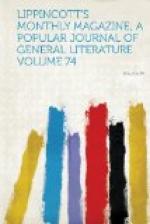Later on we asked permission to see a scapulary. It consisted of two small squares of cloth, herring-boned round the edge, and united by a narrow ribbon of sufficient length to permit one square to rest on the breast, whilst the other hung between the shoulders. That in front bore the image of the Virgin, designed by the nuns in the convent, whilst the simpler work had been given to some poor old woman, or even man, who was past harder employment. The privilege of wearing this charmed badge entailed the payment of a small yearly subscription and the repetition of seven Paternosters daily.
The procession followed the sermon. Mary, Joseph, Saint Nothburg (once a good peasant-girl, now a saint) were paraded round the village by children, and borne back to church. Peasant-men staggered under large silk banners, which swayed and fluttered in the blustery wind, and, but for the steady grasp of the strong men who carried them, threatening at each moment to crush the pious throng. The four chief peasants of the district, wearing their robes of state, the Noah’s ark coats in which they were married, bore the baldachin over the head of the Capuchin who elevated the Host: the village priest, in white surplice and Hessian boots, swung the censer at his side. The men were in front, the women, a long, broad file, divided in the procession by the priests from their male relations, followed—a dense black mass, but relieved in color by the whiteness of their short linen sleeves.
Men and women, carefully severed in their prayers and on the very steps of the altar by Holy Church, were soon able to come together again under the spacious, hospitable roof of Herr Kappler, the wirth. Innumerable clean wooden tables, forms, and stiff, high-legged wooden chairs were ranged up stairs and down stairs and in the orchard without, for the accommodation of the scapularists and their friends.
We sat at a side-table in an upper room partaking of grilled fowl and salad, whilst buben and their dirnen, or lads and their lasses, middle-aged couples, old men and women, poured into the house, filling every chair, bench and table. They came thither from all the country-side, and endless were the greetings amongst cousins and cousins’ cousins. The Tyrolese, like the Scotch, keep up every link of relationship, claiming the fiftieth cousin. Relationship, in fact, never does die out; and though it may become an abstract during busy seasons of ploughing and sowing, it becomes a strong reality at wakes and festivals. Thus, at Kappler’s, on this scapulary afternoon, Barthel’s brother-in-law’s cousin drank with “Cousin Barthel,” and Seppl’s sister-in-law’s niece was treated by “Onkel Seppl.” There was one square-built, good-humored old man who appeared to be the whole world’s cousin: he passed from table to table, and had to sip from fifty offered glasses.




